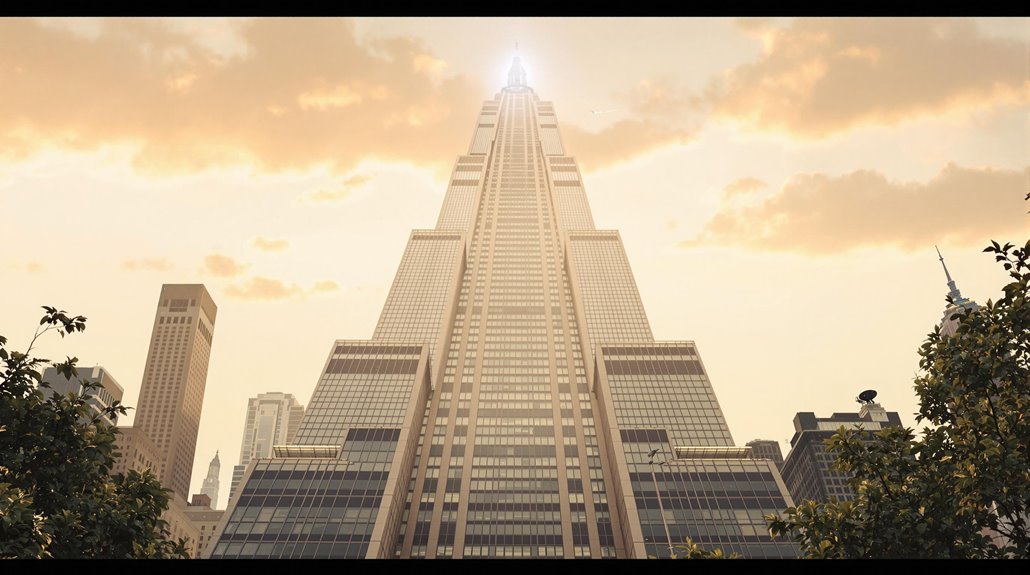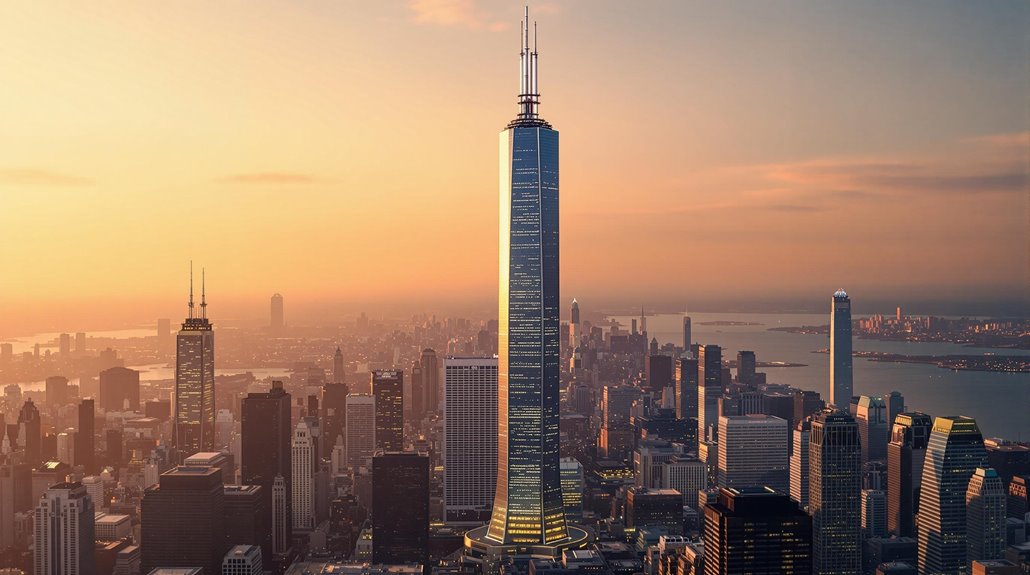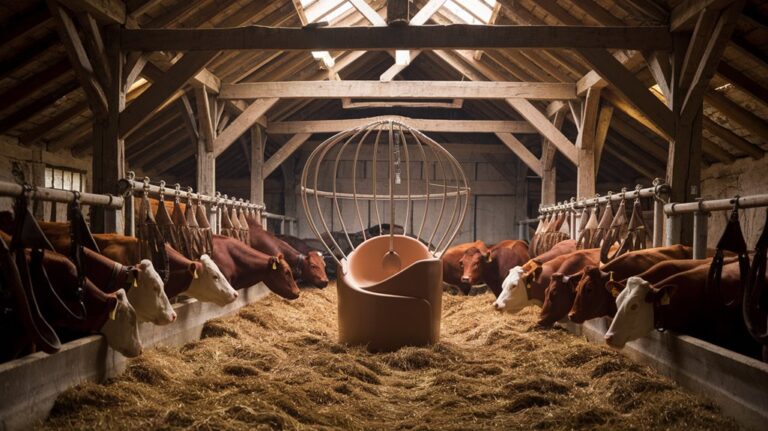Fazlur Rahman Khan’s Skyscraper Tube: The Day He Stood at the Top of Willis Tower
You'd never guess that a single structural design could reshape every major skyline on Earth, but that's exactly what Fazlur Rahman Khan achieved with his tubular system. As you walk past any modern skyscraper, you're witnessing his revolutionary approach that changed how we build upward. When Khan first stood atop the Willis Tower in Chicago, he wasn't just admiring the view—he was witnessing the future of architecture unfold before him. What happened that day would forever transform urban engineering.
The Birth of the Tubular Frame Revolution

While studying the natural strength of bamboo structures in his native Dhaka, Bangladesh, Fazlur Rahman Khan conceived a revolutionary approach to skyscraper design that would transform modern architecture.
Working at Skidmore, Owings & Merrill in 1963, he envisioned buildings as thin-walled tubes with closely spaced columns and beams around their perimeters. His system utilized a rigid exterior frame that functioned as a structural wall to resist lateral forces.
This architectural evolution wasn't just aesthetic – you'll find that Khan's tubular structures offered remarkable advantages.
They've increased stability against wind forces while reducing the need for interior columns.
Khan earned his engineering master's degree from MIT in 1957, where he developed the mathematical foundations for his future innovations.
You're looking at a system that cut steel usage by up to 50% compared to conventional designs, making buildings both lighter and stronger.
The DeWitt-Chestnut Apartment Building in Chicago became the first structure to showcase this innovative concept, paving the way for iconic skyscrapers like the John Hancock Center and Willis Tower.
A Vision That Changed Chicago's Skyline
Fazlur Khan's revolutionary tube design transformed Chicago's skyline most dramatically through the Willis Tower, a 110-story colossus that dominated the global architectural landscape for decades.
When you look at this 1,450-foot masterpiece, you'll see how its bundled-tube system redefined the possibilities of tall building construction.
The tower's architectural significance extends far beyond Chicago, inspiring structures like the Burj Khalifa and One World Trade Center.
You'll find its urban transformation most evident in the bustling commercial hub it created, housing countless businesses and drawing 1.7 million visitors annually to its Skydeck.
The building's innovative design includes high-speed elevators that can transport visitors at an impressive 1,600 feet per minute.
From the 103rd floor, you can witness Khan's vision in full glory – a demonstration of engineering brilliance that's honored by "Fazlur R. Khan Way" and a dedicated sculpture at the tower's base.
The tower's construction was driven by Sears' remarkable growth, as the company needed space for their 7,000 employees in a single headquarters building.
Engineering Meets Artistry: The Willis Tower Design
The marvel of Willis Tower's engineering lies in its groundbreaking bundled tube system – nine massive tubes arranged in a 3×3 grid that revolutionized skyscraper design.
You'll notice how the tubes stop at different heights, creating the tower's iconic stepped appearance while maximizing structural aesthetics and stability against lateral forces. Originally envisioned by Sears Roebuck & Co., the tower's design prioritized flexible office spaces that could accommodate their massive workforce. The project was championed by Bruce Graham and marked a significant breakthrough in structural engineering.
The innovative materials used in construction showcase remarkable efficiency: just 33 pounds of steel per square foot, half of what the Empire State Building required.
As you explore the structure, you'll find that rigid joints connect the columns and beams, while diagonal bracing appears only below setbacks.
The design's brilliance extends underground, where a 50-foot-deep basement rests on a five-foot-thick concrete slab, supported by 201 caissons that guarantee the tower's stability in Chicago's challenging soil conditions.
Breaking Ground: Three Years of Innovation
In 1969, Khan's revolutionary bundled tube concept moved from blueprint to reality as planning began for what would become Chicago's tallest structure.
You'd be amazed by how quickly the innovative design progressed from concept to construction, taking just three years to complete at a cost of $150 million.
The construction techniques were groundbreaking: workers assembled nine massive tubes in a 3×3 grid pattern, with some tubes reaching different heights to create the iconic stepped profile. Khan worked closely with architect Bruce Graham on this monumental project.
While traditional skyscrapers relied on expensive concrete cores, Khan's design challenges were solved through his ingenious bundled tube system. This approach minimized lateral forces and added rigidity while using less material. The building's completion in 1973 marked its status as the world's tallest building.
The Day Khan Reached New Heights

When Willis Tower first pierced Chicago's skyline in 1973, you'd never guess its revolutionary design came from a humble immigrant who transformed structural engineering forever.
Khan's determination led him to develop the ingenious bundled tube system, creating a building that would stand against Chicago's fierce winds while reaching unprecedented heights of 110 stories.
You can see the architectural challenges he overcame in every aspect of the tower's design. His innovative 3×3 grid of nine tubes eliminated the need for traditional concrete cores, making the structure both more stable and cost-effective. While working at Skidmore, Owings & Merrill, Khan developed many of his groundbreaking engineering concepts.
As a Muslim immigrant from Bangladesh who earned three advanced degrees in just three years, Khan proved that groundbreaking engineering could emerge from unexpected places.
His masterpiece didn't just transform Chicago's skyline—it revolutionized skyscraper design worldwide. The building's impact continues today, as Blackstone purchased the iconic structure in 2015, ensuring its legacy for future generations.
 computer structural analysis at SOM.
computer structural analysis at SOM.
His bundled tube system cut steel usage in half, promoting design sustainability long before it became a global priority.
You can see the impact in the Willis Tower, which uses just 33 pounds of steel per square foot compared to the Empire State Building's 66 pounds.
Born in Dhaka, Bangladesh, Khan achieved worldwide recognition as the Greatest Engineer of the 20th century through his groundbreaking work.
Khan's legacy lives on through the CTBUH's Fazlur Khan Lifetime Achievement Medal, recognizing those who follow his path of revolutionary structural engineering.










